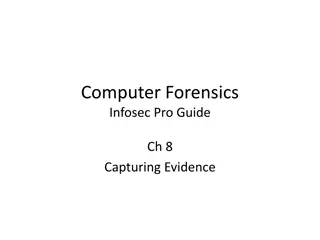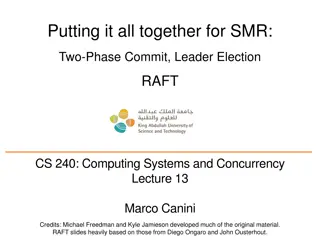Verifying Functional Correctness in Conflict-Free Replicated Data Types
Explore the significance of verifying functional correctness in Conflict-Free Replicated Data Types (CRDTs), focusing on ensuring data consistency and program logic for clients. Learn about the importance of Strong Eventual Consistency (SEC) and the necessity of separate verification with atomic specifications. Discover insights on how to ensure the correctness of client programs and CRDT implementations in modern database systems.
Download Presentation

Please find below an Image/Link to download the presentation.
The content on the website is provided AS IS for your information and personal use only. It may not be sold, licensed, or shared on other websites without obtaining consent from the author.If you encounter any issues during the download, it is possible that the publisher has removed the file from their server.
You are allowed to download the files provided on this website for personal or commercial use, subject to the condition that they are used lawfully. All files are the property of their respective owners.
The content on the website is provided AS IS for your information and personal use only. It may not be sold, licensed, or shared on other websites without obtaining consent from the author.
E N D
Presentation Transcript
Abstraction for Conflict-Free Replicated Data Types Hongjin Liang and Xinyu Feng Nanjing University
Replicated Data Types Client Program Client Program Replicated Data Types Client Program Are the local copies of the data the same? Data is replicated in modern database systems. Various protocols are proposed to ensure data consistency.
Conflict-Free Replicated Data Types (CRDTs) Widely used in real world systems, e.g. How to specify the correctness of CRDTs? Data consistency between different nodes Strong Eventual Consistency (SEC) Verified in many existing works (e.g. [Gomes et al 17, Nagar and Jagannathan 19]) SEC does not encode functionality of the data type, thus does not provide sufficient information for client reasoning.
Example: Collaborative Editing u := read(); if ( cute u) addAfter( cats , are ); Bob Alice CRDT Impl of Sequence addAfter( cats , cute ); x := read(); SEC can help verify that the final states of different nodes converge. But we also want to verify the functional correctness of the whole program: e.g. the final states and the value of x are cats cute or cats are cute
How to verify functional correctness of whole programs Client Program ?1 ?2 ?? CRDT Impl of Sequence CRDT Implementation Need to verify both the CRDT impl and the client program!
How to verify functional correctness of whole programs Different client programs Same client program ?1 ?2 ?? Same CRDT implementation Different CRDT impl of the data type Verify the CRDT impl once and for all? Verify the client program once and for all? To do modular and layered verification, abstraction is necessary!
Our Contributions Program logic for clients Client Program ?1 ?2 ?? Separate verification Abstraction: Strong Eventual Consistency + Functional Correctness Based on Atomic Specification Proof method for CRDTs CRDT Implementation
Our Contributions Program logic for clients Client Program ?1 ?2 ?? Verified several interesting client programs Separate verification Abstraction: Strong Eventual Consistency + Functional Correctness Based on Atomic Specification Verified replicated growable array (RGA), continuous sequence, add-wins set, remove-wins set, 2P-set, LWW-element set, grow-only set, LWW register, replicated counter, Proof method for CRDTs CRDT Implementation
Outline of this talk Overview of CRDTs Abstraction for CRDTs Other results
Overview of CRDTs Na ve RDTs may not ensure data consistency: final states of different nodes may not converge Na ve impl of replicated sequence addAfter( my , cat ) A my cat cute my cute my dog cat cute not converge! my cat dog cute my cute my dog cute B addAfter( my , dog ) We call them conflicting . Because addAfter(a, b) and addAfter(a, c) are not commutative! o addAfter(a, b) addAfter(a, c) o addAfter(a, b) addAfter(a, c) CRDTs solution: turn conflicting (non-commutative) operations into commutative ones
Conflict-Free Replicated Data Types Idea: turn conflicting (non-commutative) operations into commutative ones Continuous sequence: addAfter( my , cat , 4) A my1 cat4 cute9 my1 cat4 dog8 cute9 my1 cute9 converge! my1 dog8 cute9 my1 cute9 my1 cat4 dog8 cute9 B addAfter( my , dog , 8) Conflict Resolution Policy: real number tags to indicate positions in the sequence Commutativity of conflicting operations: o o = addAfter( my , dog , 8) addAfter( my , cat , 4) addAfter( my , dog , 8) addAfter( my , cat , 4)
Conflict-Free Replicated Data Types Idea: turn conflicting (non-commutative) operations into commutative ones Conflict resolution policies: Uniform-conflict-resolving (UCR): do not give privilege to particular operations addAfter( my , cat , 4) Continuous sequence gives equal treatment to addAfter( my , cat ) and addAfter( my , dog ) addAfter( my , dog , 8) Other examples: timestamp-based algorithms (e.g. last-writer-wins register) X-wins: rely on functionality and semantic relationship between operations e.g. add-wins set, remove-wins set
Conflict-Free Replicated Data Types Conflict resolution policies: Uniform-conflict-resolving (UCR): do not give privilege to particular operations e.g. continuous sequence, timestamp-based algorithms X-wins: rely on functionality and semantic relationship between operations e.g. add-wins set, remove-wins set Abstraction for CRDTs Focus of this talk Abstract converging consistency (ACC) for UCR CRDTs More challenging! See our paper! Extended ACC for X-wins CRDTs
Outline of this talk Overview of CRDTs Abstraction for CRDTs Other results
Our Goal What is client-reasoning-friendly abstraction? Client Program ?1 ?2 ?? two nodes states converge if they receive the same set of updates Abstraction: Strong Eventual Consistency (SEC) + Functional Correctness CRDT Implementation
What is client-reasoning-friendly abstraction? 1) Hide the impl details: use atomic abstraction of the actual operations u := read(); if ( cute u) addAfter( cats , are ); addAfter( cats , cute ); x := read(); Continuous sequence: Atomic spec: Generate addAfter( cats , cute , 4) with a real-number tag to indicate position in the sequence addAfter( cats , cute ) cats1 cats1cute4
What is client-reasoning-friendly abstraction? 1) Hide the impl details: use atomic abstraction of the actual operations 2) Each single client wants a view of sequential executions of all the actions read() addAfter( cats , are ) addAfter( cats , cute ) addAfter( cats , cute , 4) read() A cats1cute4 cats1 cats1are2 cute4 cats1cute4 cats1are2 cute4 cats1 B read() addAfter( cats , are , 2)
What is client-reasoning-friendly abstraction? 1) Hide the impl details: use atomic abstraction of the actual operations 2) Each single client wants a view of sequential executions of all the actions a) Locally (from single client s point of view): What s the relationship between abstract execution order and real-time order on this node? Crucial for functional correctness b) Globally (from whole program s point of view), to ensure state convergence (SEC): What s the relationship between abstract execution orders of different nodes?
a) Locally (from single clients point of view): What s the relationship between abstract execution order and real-time order on this node? They must lead to the same state and same observed results (to ensure functional correctness) Natural idea: directly map the real-time execution sequence to the abstract one (let the abstract execution order be the same as real-time order) cats are cute read() addAfter( cats , are ) returns cats are cute addAfter( cats , cute ) Lead to same states & same observed results addAfter( cats , cute , 4) read() returns cats are cute A cats1cute4 cats1 cats1are2 cute4 cats1are2 cute4 addAfter( cats , are , 2)
Problem: direct mapping may NOT work my cat cute my dog cat cute my cute addAfter( my , dog ) addAfter( my , cat ) addAfter( my , cat , 4) A my1 cat4 cute9 my1 cat4 dog8 cute9 my1 cute9 my1 dog8 cute9 my1 cute9 my1 cat4 dog8 cute9 B addAfter( my , dog , 8)
Problem: direct mapping may NOT work my dog cat cute addAfter( my , dog ) addAfter( my , cat ) my cat dog cute addAfter( my , cat , 4) A my1 cat4 cute9 my1 cat4 dog8 cute9 my1 cute9 my1 dog8 cute9 my1 cute9 my1 cat4 dog8 cute9 B addAfter( my , dog , 8) Need to allow the abstract execution order to be different from the real-time order (while preserving the program order of the current node)
What is client-reasoning-friendly abstraction? 1) Hide the impl details: use atomic abstraction of the actual operations 2) Each single client wants a view of sequential executions of all the actions a) Locally (from single client s point of view), to ensure functional correctness: What s the relationship between abstract execution order and real-time order on this node? They can be different, but must lead to the same state b) Globally (from whole program s point of view), to ensure state convergence (SEC): What s the relationship between abstract execution orders of different nodes? Sometimes they have to be different ...
Different nodes may observe different abstract execution orders po conf-resolving conf-resolving my cat dog is black white black dog addAfter( is , white ) addAfter( is , black ) addAfter( my , dog ) addAfter( my , cat ) addAfter( my , cat , 4) addAfter( is , white , 14) my1 cat4 dog8 is10 black12 white14 A my1 cat4 is10 my1 cat4 is10 white14 my1 is10 my1 dog8 is10 black12 my1 is10 my1 is10 black12 my1 cat4 dog8 is10 black12 white14 B addAfter( is , black , 12) addAfter( my , dog , 8) my cat dog is black white cat addAfter( my , dog ) conf-resolving addAfter( my , cat ) addAfter( is , white ) conf-resolving addAfter( is , black ) white po
Different nodes may observe different abstract execution orders, but conflicting operations should follow the same abstract order (to ensure SEC) addAfter( my , cat , 4) addAfter( is , white , 14) my1 cat4 dog8 is10 black12 white14 A my1 cat4 is10 my1 cat4 is10 white14 my1 is10 my1 dog8 is10 black12 my1 is10 my1 is10 black12 my1 cat4 dog8 is10 black12 white14 B addAfter( is , black , 12) addAfter( my , dog , 8)
Abstract Converging Consistency (ACC) for UCR-CRDTs CRDT impl Atomic operations Conflict relation between abstract atomic operations ACC(O, (S, )) iff for any real-time execution of O, each node can find a sequential execution of abstract atomic operations of S, such that a) the abstract execution order and real-time order can be different, but they must lead to the same state Functional correctness b) different nodes may observe different abstract execution orders, but conflicting operations should follow the same abstract order State convergence (SEC)
ACC is insufficient for X-wins CRDTs ACC(O, (S, )) iff conflicting operations should follow the same abstract order not specify any constraints on the order But for X-wins CRDTs like add-wins set and remove-wins set, we may rely on the specific policy (X-wins) to reason about clients.
Extended ACC for X-wins CRDTs ACC(O, (S, )) For UCR-CRDTs: XACC(O, (S, , won-by, canceled-by)) For X-wins CRDTs: New specifications to encode the X-wins policy Assume causal delivery Satisfied by add-wins set and remove-wins set
Outline of this talk Overview of CRDTs Abstraction for CRDTs Other results
Properties of ACC (and XACC) If ACC(O, (S, )), then SEC(O). Compositionality: If ACC(O1, (S1, ?)) and ACC(O2, (S2, ?)), then ACC(O1 O2, (S1 S2, ? ?)).
Abstraction Theorem ACC(O, (S, )) O (S, ) (Similar for XACC.) Contextual Refinement: O (S, ) iff C. Behaviors(C[O]) Behaviors(C[(S, )]) To verify C[O], we can verify C[(S, )] instead. Program logic for clients of UCR-CRDTs Verify C[(S, )] Proof method for UCR-CRDT implementations Verify ACC(O, (S, )) Correctness of C[O]
Conclusion Program logic for clients Client Program ?1 ?2 ?? Separate verification Abstraction: Atomic Spec S and ACC(O, (S, )) and XACC(O, (S, , won-by, canceled-by)) Proof method for CRDTs CRDT Implementation
Conclusion Program logic for clients Client Program ?1 ?2 ?? Verified several interesting client programs Separate verification Abstraction: Atomic Spec S and ACC(O, (S, )) and XACC(O, (S, , won-by, canceled-by)) Verified replicated growable array (RGA), continuous sequence, add-wins set, remove-wins set, 2P-set, LWW-element set, grow-only set, LWW register, replicated counter, Proof method for CRDTs CRDT Implementation























